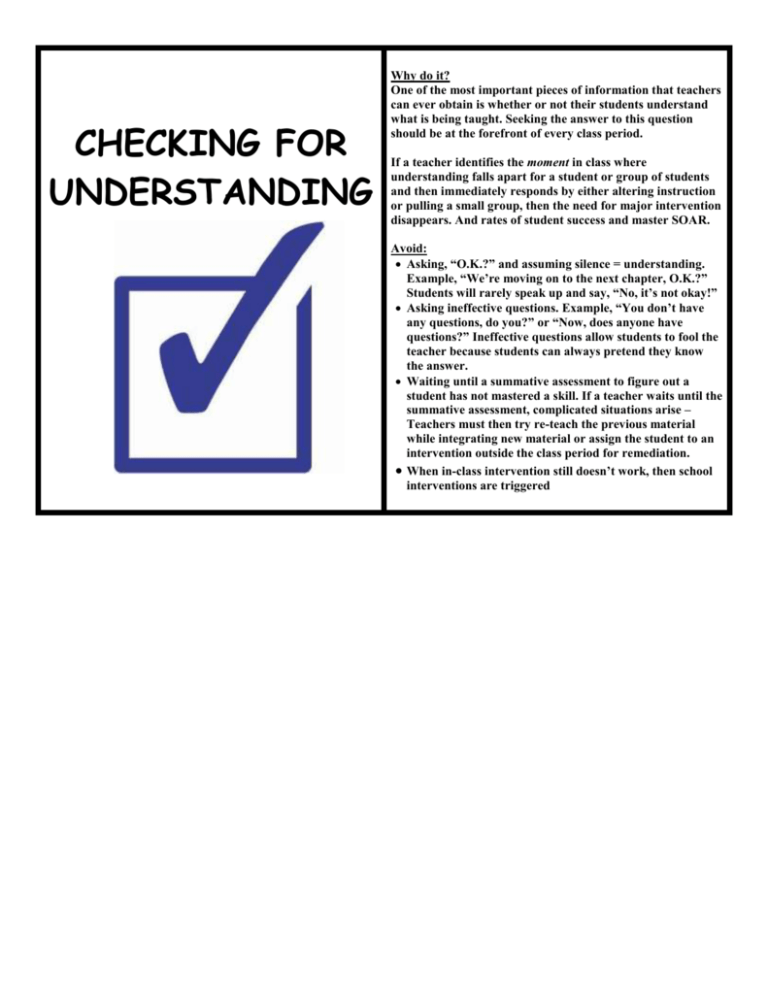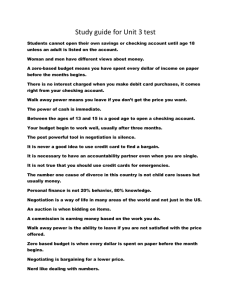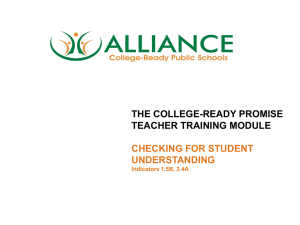Checking for Understanding strategies
advertisement

CHECKING FOR UNDERSTANDING Why do it? One of the most important pieces of information that teachers can ever obtain is whether or not their students understand what is being taught. Seeking the answer to this question should be at the forefront of every class period. If a teacher identifies the moment in class where understanding falls apart for a student or group of students and then immediately responds by either altering instruction or pulling a small group, then the need for major intervention disappears. And rates of student success and master SOAR. Avoid: Asking, “O.K.?” and assuming silence = understanding. Example, “We’re moving on to the next chapter, O.K.?” Students will rarely speak up and say, “No, it’s not okay!” Asking ineffective questions. Example, “You don’t have any questions, do you?” or “Now, does anyone have questions?” Ineffective questions allow students to fool the teacher because students can always pretend they know the answer. Waiting until a summative assessment to figure out a student has not mastered a skill. If a teacher waits until the summative assessment, complicated situations arise – Teachers must then try re-teach the previous material while integrating new material or assign the student to an intervention outside the class period for remediation. When in-class intervention still doesn’t work, then school interventions are triggered Checking For Understanding Strategy: Response Cards Teacher poses question or problem after teaching a skill/concept. Students write answer/response on an index card, small whiteboard or using SMART technology. OR – teacher can create laminated cards in three different color and students hold up the color that reflects their understanding (Green – I got it! Yellow – I’m struggling with it. Red – I’m totally lost!) Teacher immediately gains feedback regarding student understanding Teacher then pulls small group for immediate reteach while students who have mastered concept engage in individual work OR immediately presents concept in a different way and re-checks for understanding Always ask: How will I respond when students still don’t learn? Checking for Understanding Strategy: Ticket Out (or In) the Door Teacher poses a question for students based on the concepts that have been taught or will be taught, depending on the purpose. Teacher can also ask students to create a metaphor on their ticket out the door: ________________ is like__________because__________. Students write the answer on small slips of paper and turn in as they leave the room (or, conversely, they can write and turn in at the beginning of the class) Teacher reads through tickets to gauge student mastery/understanding Teacher then pulls small group for immediate reteach while students who have mastered concept engage in individual work OR immediately presents concept in a different way and re-checks for understanding Always ask: How will I respond when students still don’t learn? Checking For Understanding Strategy: Correct a Misconception Checking for Understanding Strategy: Turn and Talk After teaching a strategy or concept, teacher deliberately asks or poses a statement that is incorrect. Example - In math, the teacher could post a problem that is solved incorrectly and ask students to analyze it. The teacher then asks individual students/ pairs of students to figure out if the statement or problem is correct & explain why it is incorrect. Teacher tells students that everyone should be prepared to share out. Teacher circulates around the room, listening and watching, stepping in to correct misconceptions & making mental notes of struggling students Teacher ask groups to share their process for figuring out the misconception or teacher can share general comments about what was heard. Teacher can pull small groups or re-design instruction immediately Always ask: How will I respond when students still don’t learn? After presenting a concept/skill, students turn and talk for three minutes with a partner. Teacher can pose a question, ask students to summarize, ask students to ask their partner a question, etc. Talk is accountable – meaning that students have been taught how to engage in conversation through norms and practice; they have been given dialogue stems to use with their partner, such as: 1. 2. 3. Can you describe what you mean? I don’t agree because… Can you give me an example… As students engage in talk, teacher circulates & listens for ideas to highlight & also for struggling students Teacher then pulls small group for immediate reteach while students who have mastered concept engage in individual work OR immediately presents concept in a different way and re-checks for understanding Always ask: How will I respond when students still don’t learn? Checking For Understanding Strategy: Hand Signals Checking For Understanding Strategy: Golden Line Teacher teaches students that holding up one finger means “Agree” and two fingers means “Disagree” OR a thumbs down means “Disagree” and a peace sign means “Agree” After reading or instruction, teacher poses a comprehension or inferencing/hypothesis question/statement such as, “Lincoln created a national banking system with the National Banking Act in 1863, resulting in a standardized currency, correct?” OR “If you mix food coloring with room temperature buttermilk the color will explode across the surface, right?” Teacher then responds to results byingpulls small group for immediate re-teach while students who have mastered concept engage in individual work OR immediately presents concept in a different way and re-checks for understanding. Always ask: How will I respond when students still don’t learn? Before reading any piece of text, teacher sets a purpose by asking students to find a “golden line” – a sentence or two that is meaningful to them. Students read and highlight (or record or using a sticky note to mark) their golden line. After reading, students pair up and read their golden line to a partner & explain why they chose it. Teacher monitors by walking around, listening to student responses and noting if many students chose the same or similar lines. Teacher also notes if students chose significant or meaningful lines and the explanation of the process they used to choose the line. Teacher receives an insight to student understanding of the reading or concept Teacher then pulls small group for immediate reteach while students who have mastered concept engage in individual work OR immediately presents concept in a different way and re-checks for understanding Always ask: How will I respond when students still don’t learn? Checking for Understanding Strategy: 3 to 1 Checking For Understanding Strategy: Think and Ink After teaching a concept stop and ask students to write down the three most important words from the lesson. They then turn and talk to a partner and with a partner narrow the words down to 1 key word The teacher rotates and listens to conversations The groups now share out their word and explains why it is the most important Teacher then pulls small group for immediate reteach while students who have mastered concept engage in individual work OR immediately presents concept in a different way and re-checks for understanding Always ask: How will I respond when students still don’t learn? Pose a question, scenario, problem, what if statement… to the class Ask the class to write about this in their journal/interactive notebooks Circulate around the class to read what is being written-mark student journals when they have answered in a way that demonstrates understanding Have students with marks share and allow others to add to their journaling Checking for Understanding Strategy:Turning Points Technology Checking for Understanding Strategy: Silent Discussion Pose a question or problem with possible answers to the class Have students use the turning points to select an answer Discuss the responses given Discuss the data in order to reinforce statistical learning objectives and allow students to draw conclusions Poll Everywhere is a classroom response system that uses mobile phones, twitter, and the web. Responses are displayed in real-time in charts. Pose a question, scenario, what if statement to the class Have students pass notes at their table discussing the question Circulate around the room reading some of the notes to assess understanding Randomly select students to share what their group discussed Checking for Understanding Strategy: Whiteboards (Turning Points with no technology) Pose a question or problem to the class Have students reply on whiteboards Have students hold up whiteboards to check for understanding If you don’t have a class set of whiteboards, cardstock in a sheet protector works the same way Checking For Understanding Strategy: Picture It! Create an illustration of a word, concept, or as a summary of a piece of text Add a caption to the illustration Checking for Understanding Strategy: Traffic Light Cups Students place color cups on their desk to signal level of need Use also during group work to signal the teacher when help or feedback is needed. -Green cup-group/student is proceeding and no assistance is needed -Yellow cup-students are continuing to work, but need teacher assistance Teacher is constantly moving around the room monitoring groups and providing assistance, when needed Checking for Understanding Strategy: Human Scatterplots Teacher creates a grid in the classroom as shown above Students respond to a question by moving to a position on the “floor graph” that corresponds to their choice and how confident they are in their choice Teacher and students have a “snapshot” of the class’ understanding and confidence level Modification: Create the same grid on paper, have students initial “hot dots” and place on the paper Checking for Understanding Strategy: Whiteboards (Turning Points with no technology) Pose a question or problem to the class Have students reply on whiteboards Have students hold up whiteboards to check for understanding If you don’t have a class set of whiteboards, cardstock in a sheet protector works the same way Checking for Understanding Strategy: 4 Corners Label the 4 corners of the classroom with the letters A, B, C, or D (or 4 words or concepts) Pose a question to the class and have students move to their answer choice Have students discuss why they chose the answer and their solution process; as students listen to their peers reasoning they may choose to move to a different corner Circulate around the 4 corners listening and clarifying misconceptions until all students come to a consensus Checking For Understanding Strategy: Picture It! Create an illustration of a word, concept, or as a summary of a piece of text Add a caption to the illustration Checking for Understanding Strategy: 3-2-1 Students respond in writing to 3 reflective prompts Teacher uses information to assess how well the learning goals were achieved and what topics may need a re-teach or small group instruction Prompts should be changed periodically Sample: -Three key ideas I remember -Two things I am struggling with -One thing that will help me tomorrow






